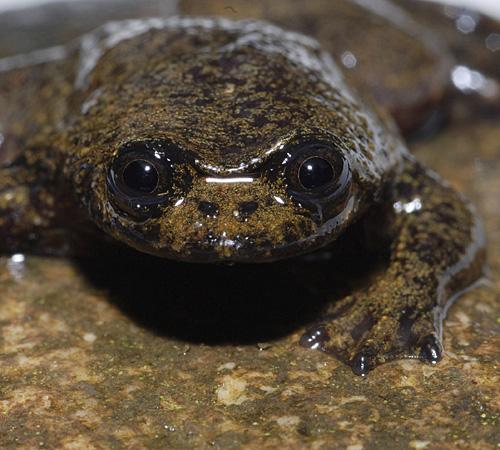Lungless aquatic frog proves rare discovery

In this photo released by David Bickford, an aquatic frog that has no lungs and breathes through its skin is shown Aug. 14, 2007, in Indonesia. David Bickford, The Associated Press
April 11, 2008
BANGKOK, Thailand – A frog has been found in a remote part of Indonesia that has no lungs and breathes through its skin, a discovery that researchers said Thursday could provide insight into what drives evolution in certain species.
The aquatic frog Barbourula kalimantanensis was found in a remote part of Indonesia’s Kalimantan province on Borneo island during an expedition in August 2007, said David Bickford, an evolutionary biologist at the National University of Singapore. Bickford was part of the trip and co-authored a paper on the find that appeared in this week’s edition of the peer-reviewed journal Current Biology.
Bickford says the species is the first frog known to science without lungs and joins a short list of amphibians with this unusual trait, including a few species of salamanders and a wormlike creature known as a caecilian.
“These are about the most ancient and bizarre frogs you can get on the planet,” Bickford said of the brown amphibian with bulging eyes and a tendency to flatten itself as it glides across the water.
“They are like a squished version of Jabba the Hutt,” he said, referring to the character from Star Wars. “They are flat and have eyes that float above the water. They have skin flaps coming off their arms and legs.”
Get The Daily Illini in your inbox!
Along with the lungless frog, Bickford said his team discovered two new lizard species and four other species of frogs during their two-month trip.
Bickford’s Indonesian colleague, Djoko Iskandar, first came across the frog 30 years ago and the biology professor from the Bandung Institute of Technology has been searching for it ever since. Five earlier expeditions had proven fruitless.
Iskandar said it was exciting to see the frog alive in its natural environment but another thing altogether to realize it was lungless. The first sign that something was unusual with the frog was after it was captured in the field. The first specimen died in a bucket of water, which prompted the researchers to take the remaining frogs back to the lab for further investigation.
“We just suspected that something was peculiar about this frog because it died even in water,” Iskandar said. “When we cut it open, we found it had no lungs, no trachea not even a wind pipe.”
Graeme Gillespie, director of conservation and science at Zoos Victoria in Australia, called the frog “evolutionarily unique.” He said the eight specimens examined in the lab showed that lunglessness was consistent with the species and not “a freak of nature.”
Bickford surmised that the frog had evolved to adapt to its difficult surroundings, in which it has to navigate cold, rapidly moving streams that are rich in oxygen.
“It’s an extreme adaptation that was probably brought about by these fast-moving streams,” Bickford said, adding that it probably needed to reduce its buoyancy in order to keep from being swept down the mountainous rivers.
He said the frog could help scientists understand the environmental factors that contribute to “extreme evolutionary change” since its closest relative in the Philippines and other frogs have lungs.






